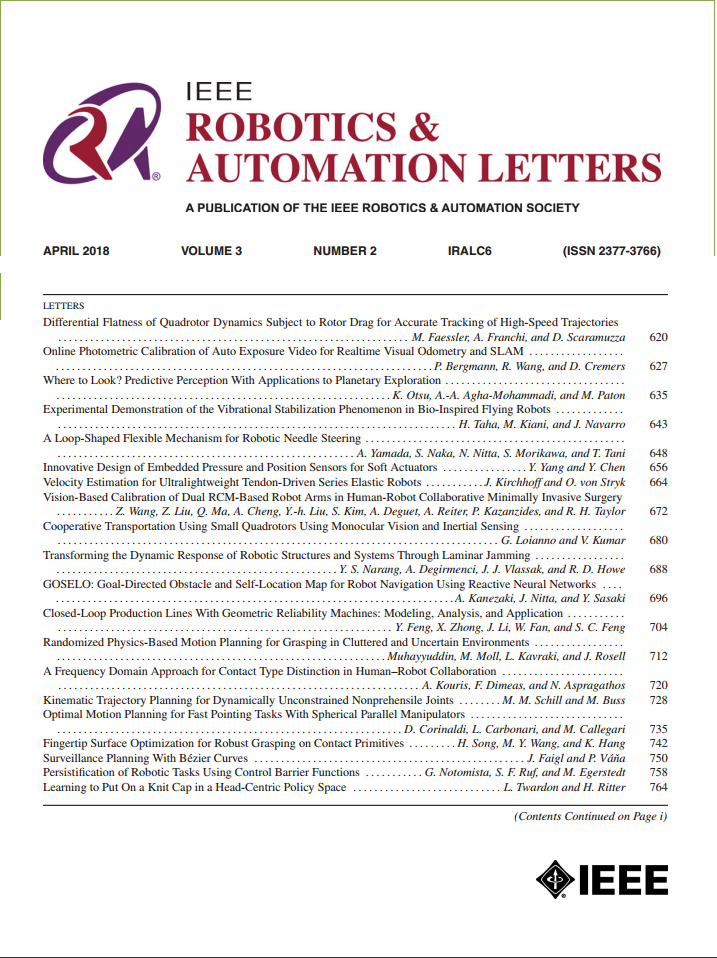EPIC: A Lightweight LiDAR-Based AAV Exploration Framework for Large-Scale Scenarios
IF 4.6
2区 计算机科学
Q2 ROBOTICS
引用次数: 0
Abstract
Autonomous exploration is a fundamental problem for various applications of autonomous aerial vehicles (AAVs). Recently, LiDAR-based exploration has gained significant attention due to its ability to generate high-precision point cloud maps of large-scale environments. While the point clouds are inherently informative for navigation, many existing exploration methods still rely on additional, often expensive, environmental representations. This reliance stems from two main reasons: the need for frontier detection or information gain computation, which typically depends on memory-intensive occupancy grid maps, and the high computational complexity of path planning directly on point clouds, primarily due to costly collision checking. To address these limitations, we present EPIC, a lightweight LiDAR-based AAV exploration framework that directly exploits point cloud data to explore large-scale environments. EPIC introduces a novel observation map based on the quality of point clouds, treating the environment as a collection of small surface patches and evaluating their observation quality. It maintains and updates this quality using spatial hashing. By guiding the AAV from well-observed to poorly-observed areas, EPIC eliminates the need for global occupancy grid maps, while ensuring robust exploration and effective performance across diverse environments. We also propose an incremental topological graph construction method operating directly on point clouds, enabling real-time path planning in large-scale environments. Leveraging these components, we build a hierarchical planning framework that generates agile and energy-efficient trajectories, achieving significantly reduced memory consumption and computation time compared to most existing methods. Extensive simulations and real-world experiments demonstrate that EPIC achieves faster exploration while significantly reducing memory consumption compared to state-of-the-art methods.EPIC: 基于激光雷达的轻量级 AAV 大型场景探索框架
自主探测是自主飞行器各种应用中的一个基本问题。近年来,基于激光雷达的探测因其能够生成大规模环境的高精度点云图而备受关注。虽然点云本身具有导航信息,但许多现有的勘探方法仍然依赖于额外的、通常昂贵的环境表示。这种依赖源于两个主要原因:需要边界检测或信息增益计算,这通常依赖于内存密集型占用网格图,以及直接在点云上进行路径规划的高计算复杂性,主要是由于昂贵的碰撞检查。为了解决这些限制,我们提出了EPIC,这是一个轻量级的基于激光雷达的AAV探索框架,直接利用点云数据来探索大规模环境。EPIC引入了一种基于点云质量的新型观测图,将环境视为小表面斑块的集合并评估其观测质量。它使用空间散列来维护和更新这种质量。通过引导AAV从观察良好的区域到观察不佳的区域,EPIC消除了对全球占用网格地图的需求,同时确保了在不同环境下的强大勘探和有效性能。我们还提出了一种直接在点云上操作的增量拓扑图构建方法,实现了大规模环境下的实时路径规划。利用这些组件,我们构建了一个分层规划框架,生成敏捷和节能的轨迹,与大多数现有方法相比,显著减少了内存消耗和计算时间。大量的模拟和现实世界的实验表明,与最先进的方法相比,EPIC实现了更快的探索,同时显着降低了内存消耗。
本文章由计算机程序翻译,如有差异,请以英文原文为准。
求助全文
约1分钟内获得全文
求助全文
来源期刊

IEEE Robotics and Automation Letters
Computer Science-Computer Science Applications
CiteScore
9.60
自引率
15.40%
发文量
1428
期刊介绍:
The scope of this journal is to publish peer-reviewed articles that provide a timely and concise account of innovative research ideas and application results, reporting significant theoretical findings and application case studies in areas of robotics and automation.
 求助内容:
求助内容: 应助结果提醒方式:
应助结果提醒方式:


